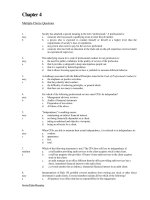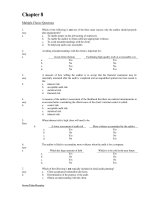Lecture Auditing and assurance services (Second international edition) Chapter 12 Auditing the human resource management process
Bạn đang xem bản rút gọn của tài liệu. Xem và tải ngay bản đầy đủ của tài liệu tại đây (850.56 KB, 28 trang )
Chapter Twelve
Auditing the
Human Resource
Management
Process
McGraw-Hill/Irwin
© The McGraw-Hill Companies 2010
Overview of the Human Resource
Management Process
The human resource process starts with the
establishment of sound policies for hiring,
training, evaluating, counseling, promoting,
compensating and taking remedial actions for
employees.
The main concern of the auditor involves
payroll transactions once an employee has
been hired.
McGraw-Hill/Irwin
© The McGraw-Hill Companies 2010
Flowchart for EarthWear Clothiers
Departments
Operating
Human
Resource
Initiates
personnel
changes
Payroll
master file
changes
Time
sheets
Reviews
master file
change
report
Approved
by
supervisor
McGraw-Hill/Irwin
Review
By
date
© The McGraw-Hill Companies 2010
Payroll
Payroll
master file
changes
Time
sheets
Input
Error
corrections
To IT
From IT
Flowchart for EarthWear Clothiers
Departments
Payroll
Error
corrections
IT
Payroll
master
file
Payroll
processing
Payroll
reporting
Error
report
McGraw-Hill/Irwin
Payroll
cheques
General
ledger
Payroll
register
Payroll
register
Periodic
payroll
reports
Review
by date
Payroll master
file changes
report
Tax reports
and forms
© The McGraw-Hill Companies 2010
Types of Transactions and Financial
Statement Accounts Affected
Two types of transactions are typically processed
through the human resource management process:
1. Payments to employees for services rendered.
2. Accrual and payment of payroll-related liabilities
arising from employees’ services, including
liabilities for payroll taxes and pensions.
McGraw-Hill/Irwin
© The McGraw-Hill Companies 2010
Financial Statement Accounts Affected
McGraw-Hill/Irwin
© The McGraw-Hill Companies 2010
Types of Documents and Records
McGraw-Hill/Irwin
© The McGraw-Hill Companies 2010
The Major Functions
McGraw-Hill/Irwin
© The McGraw-Hill Companies 2010
Segregation of Duties
McGraw-Hill/Irwin
© The McGraw-Hill Companies 2010
Inherent Risk Assessment
In assessing inherent risk the auditor may want to
consider the effect of economic conditions on
payroll costs, the supply of skilled workers and
the frequency of employee turnover. The auditor
should be familiar with any existing labour
contracts and the impact of regulation on the
company.
The inherent risk
associated with non-officers
of the company is
generally considered low.
McGraw-Hill/Irwin
© The McGraw-Hill Companies 2010
The inherent risk associated with
officers of the company may not
be considered low because of the
ability to take advantage of their
high position.
Control Risk Assessment
Understand and document the human
resource management process based
on a reliance approach.
Plan and perform tests of controls on
payroll transactions.
Set and document the control risk for
the human resource management
process.
McGraw-Hill/Irwin
© The McGraw-Hill Companies 2010
Control Activities and Test of Controls –
Payroll Transactions
Occurrence of Payroll Transactions
The auditor want assurance that payments for
payroll-related services are being made to valid
employees for time actually worked.
Controls must be in place to ensure
that no payments are made to fictitious
employees and payments to valid employees
are stopped once the employee is terminated.
McGraw-Hill/Irwin
© The McGraw-Hill Companies 2010
Control Activities and Test of Controls –
Payroll Transactions
Authorization of Payroll Transactions
The client must have controls for hiring and
terminating employees, setting pay rates,
making withholdings, awarding benefits,
making direct deposits to employees’ accounts
and issuing payroll cheques.
McGraw-Hill/Irwin
© The McGraw-Hill Companies 2010
Control Activities and Test of Controls –
Payroll Transactions
Accuracy of Payroll Transactions
The auditor’s main concern is that the
employee’s gross pay and payroll deductions
may be incorrectly computed.
McGraw-Hill/Irwin
© The McGraw-Hill Companies 2010
Control Activities and Test of Controls –
Payroll Transactions
Classification of Payroll Transactions
If payroll expense is charged to the wrong
accounts, the financial statement may be
misstated. If payroll expense is not properly
classified between direct and indirect labour,
inventory and cost of goods sold may not be
valued properly.
McGraw-Hill/Irwin
© The McGraw-Hill Companies 2010
Relating the Assessed Level of Control Risk
to Substantive Procedures
If the results of the tests of controls for the
payroll system support the planned level of
control risk, the auditor conducts substantive
procedures of payroll-related accounts at the
assessed level. If the tests do not support the
level of control risk, the nature and extent of
substantive testing will be increased.
McGraw-Hill/Irwin
© The McGraw-Hill Companies 2010
Auditing Payroll-Related Accounts
Substantive Analytical Procedures
McGraw-Hill/Irwin
© The McGraw-Hill Companies 2010
Tests of Detail of Transactions, Account
Balances and Disclosures
McGraw-Hill/Irwin
© The McGraw-Hill Companies 2010
Tests of Detail of Transactions, Account
Balances and Disclosures
McGraw-Hill/Irwin
© The McGraw-Hill Companies 2010
Tests of Detail of Transactions, Account
Balances and Disclosures
McGraw-Hill/Irwin
© The McGraw-Hill Companies 2010
Payroll Expense Accounts
Payroll transactions affect many expense accounts,
including direct and indirect manufacturing expense,
general and administrative salaries, sales salaries,
commissions and payroll tax expenses.
If the entity’s internal control is reliable, the
auditor does not need to conduct detailed tests of
all these payroll expense accounts. Additional
testing is necessary only when control
deficiencies exist.
McGraw-Hill/Irwin
© The McGraw-Hill Companies 2010
Accrued Payroll Liabilities
The entity incurs a number of liabilities including
payroll taxes withheld, medical and life insurance
premiums, pension and other miscellaneous
deductions.
Accrued wages
Accrued benefits
(vacation & sick pay)
and salaries
Accrued payroll
taxes
Accrued
commissions
McGraw-Hill/Irwin
© The McGraw-Hill Companies 2010
Accrued
bonuses
Accrued Payroll Liabilities
Cut-off
An examination of supporting documentation
for the accruals provides evidence on the
proper period for recording the expense or
liability.
McGraw-Hill/Irwin
© The McGraw-Hill Companies 2010
Accrued Payroll Liabilities
Existence and Valuation
To verify the existence and valuation of an
accrued payroll liability, the auditor can trace
the amounts included on the account analysis
working paper to supporting documentation
such as payroll tax reports.
McGraw-Hill/Irwin
© The McGraw-Hill Companies 2010
Accrued Payroll Liabilities
Completeness
The auditor must be aware of the normal
payroll-related taxes that are paid by the entity
and therefore should be able to determine if
accruals have been made for payroll taxes such
as social security taxes.
McGraw-Hill/Irwin
© The McGraw-Hill Companies 2010









